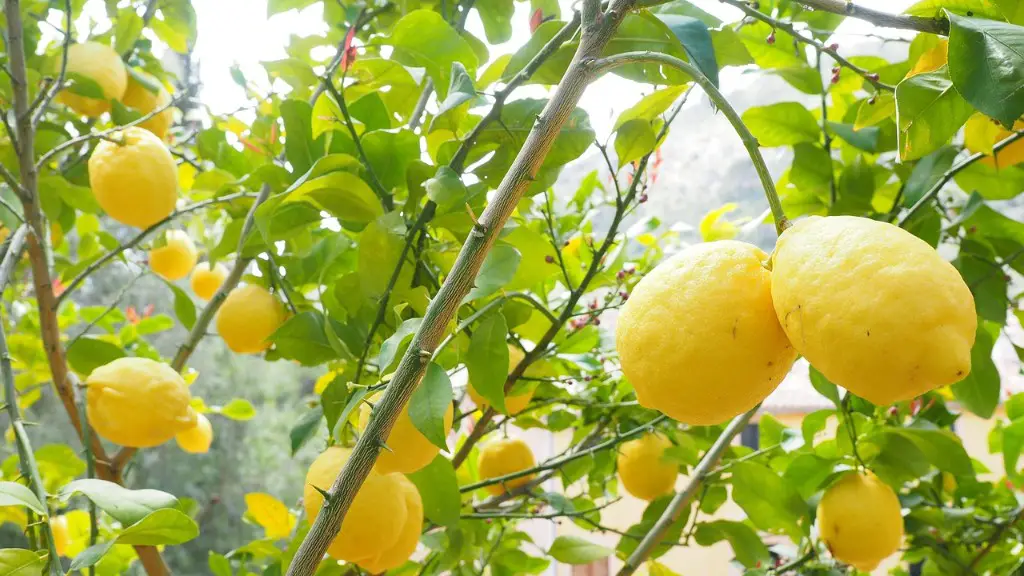Caring for a Meyer lemon tree is more complicated than most fruit trees but the rewards can be great. With proper care, the tree can produce sweet, juicy, brightly flavored lemons for many years. The first step in taking care of a Meyer lemon tree is to keep it properly watered. It’s best to water the tree about twice a week, allowing the top few inches of soil to dry out between waterings. To help retain moisture, add an organic mulch like straw, shredded bark, or compost around the base of the tree.
Meyer lemon trees should be fertilized every other month in order to encourage growth and fruiting. Choose an organic fertilizer that is high in nitrogen and phosphorus, such as a citrus fertilizer. This will provide the nutrients necessary for the tree to develop strong roots and healthy foliage. Organic fertilizers should be applied early in the spring, then again in late summer and early fall.
It’s also important to prune your Meyer lemon tree in order to maintain its shape and size. Pruning should be done annually, or as needed to remove deadwood, crossed branches, and weak or diseased limbs. Be sure not to prune too heavily, as this can reduce the amount of fruit the tree produces and if done too drastically, may even kill it.
The Meyer lemon tree does best in hot and sunny locations. Place the tree in an area of your yard that receives direct sunlight for at least six hours each day. If possible, place it in a spot that is sheltered from wind, as strong winds may cause the branches to break. During the summer, be sure to shade the tree from afternoon sun to reduce the likelihood of sunburn.
One of the most common problems with Meyer lemon trees is disease and pest infestations. The tree is particularly susceptible to fungal diseases and aphids. Inspect your tree regularly for signs of pests or disease, such as discoloured leaves, leaf spots, and sticky residue on the leaves or trunk. If you see any sign of pest activity or disease, take steps to address the problem immediately.
Lastly, Meyer lemon trees also need to be protected from freezing temperatures. During the winter months, place burlap or other breathable fabric around the tree to protect it from cold winds and frost. If temperatures are forecasted to dip below freezing, you may need to bring the tree indoors temporarily in order to protect it from damage.
Repotting
Repotting is an important component of taking care of your Meyer lemon tree. When the tree is young, it should be repotted every spring. This helps to ensure that it is getting the nutrients and space to develop a healthy root system. Once the tree is mature, it should be repotted every two to three years. Be sure to use a potting mix that is specifically designed for citrus trees.
Pruning
Pruning is an important step in caring for your Meyer lemon tree. Pruning helps to reduce the size of the tree, as well as promote healthy growth and fruiting. Start pruning your Meyer lemon tree when it is young to encourage it to grow in a pleasing shape. Once the tree is established, prune it every year. Carefully remove any dead or diseased branches and any shoots growing out of the trunk. This will help to keep the tree open, which allows for better air circulation and prevents pests from taking hold on the tree.
Winter Care
Meyer lemon trees are sensitive to cold temperatures and need to be protected from freezing. During the winter months, place a burlap or other breathable fabric around the tree to protect it from winds and frost. If temperatures are forecasted to dip below freezing, you may need to bring the tree indoors temporarily. Meyer lemon trees also need extra water during the winter months to ensure they don’t dry out, so be sure to water them regularly.
Fruit Harvesting
Fruit harvesting is one of the most rewarding components of Meyers lemon tree care. The lemons are ripe when they feel heavy for their size and the color is a yellow-orange hue. Never pull the lemons off the tree but instead cut them off with a pair of scissors or a pruning shears. The harvested Meyer lemons can be used to make jams, jellies, vinaigrettes, and more. They can also be eaten fresh, added to salads, or used to enhance a variety of dishes.

